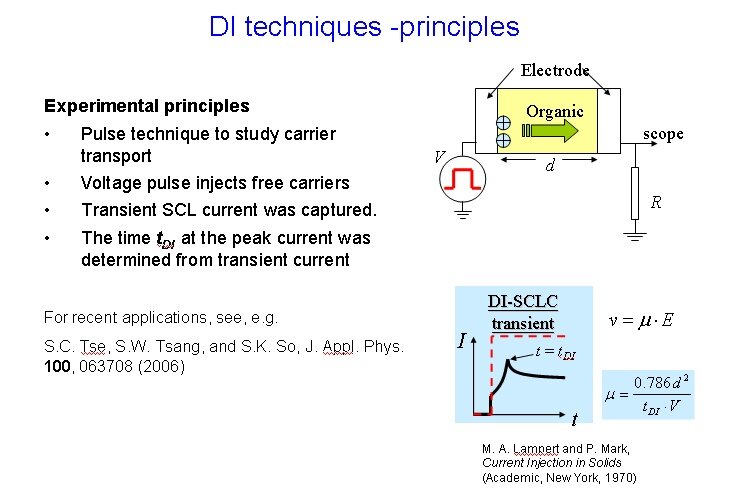Supervisor: Prof. SO, Shu Kong (Tel: (852) 3411-7038; email: skso@hkbu.edu.hk)
- Organic solar cells
Solar cells absorb photons in the visible range and convert them into from free electrons and holes. Traditionally, solar cells are constructed from semiconducting silicon. This project will investigate the possibility of using organic electronic materials for solar cells fabrication. The project is quite challenging as it comprises of sample fabrication, optical and electrical characterization, and some device modeling.
Reference:
Carr Hoi Yi Ho, Qi Dong, Hang Yin, Winky Wing Ki Leung, Qingdan Yang, Harrison Ka Hin Lee, Sai Wing Tsang, and Shu Kong So
Impact of Solvent Additive on Carrier Transport in Polymer:Fullerene Bulk Heterojunction Photovoltaic Cell, Advanced Materials Interfaces 2, 1500166 (2015).
Harrison Ka Hin Lee, Zhao Li, Iordania Constantinou, Franky So, Sai Wing Tsang, and Shu Kong So
Batch-to-Batch Variation of Polymeric Photovoltaic Materials: its Origin and Impacts on Charge Carrier Transport and Device Performances, Advanced Energy Material 4, 1400768 (2014).
- Dark injection space-charge-limited-current
Organic electronic devices are now widely used in optoelectronics. Examples are organic light-emitting diodes (OLEDs) and organic thin film transistors (OTFTs). The technology has matured sufficiently, and commercial products such as flat panel displays are beginning to be available. In these devices, they typically have a structure of anode/organic materials/cathode. Proper operations of devices require the injection of external charge carriers from the contact electrodes into the active organic electronic material. Thus the ability to control and to quantify carrier injection is of critical importance for improving performances of organic electronic devices. This project uses a very useful technique, known as dark injection space-charge-limited-current (DI-SCLC), to study charge injection phenomena in organic electronic devices. The principles and merits of this technique of will be investigated. The outcome of this project will allow us to quantify the quality of a charge injection contact to an organic electronic material.

References:
S.C. Tse, S.W. Tsang, and S.K. So, "Polymeric conducting anode for small organic transporting molecules in dark injection experiments", Journal of Applied Physics 100, Art. No. 063708 (2006).
Kevin K.H. Chan, S.W. Tsang, Harrison K.H. Lee, Franky So, S.K. So,
Charge injection and transport studies of poly(2,7-carbazole) copolymer PCDTBT and their relationship to solar cell performance, Organic Electronics 13, 850-855 (2012).
- Time-of-flight measurements
The conductivity of a non-crystalline solid is determined by the mobility of charges inside the solid. The mobility is a measure of how fast charge carriers can move inside the solid. In general, the mobility is affected by temperature and external applied electric field. An effective means of measuring charge mobility in a solid is by the time-of-flight (TOF) technique. In TOF, a pulsed laser is used to create mobile carriers in the material. The time required for charges to migrate through a fixed distance is measured from which the carrier mobility is derived. The objective of this project is to use TOF to measure the mobilities of amorphous thin films and to understand their conduction mechanisms.

References:
K.K. Tsung and S.K. So,
Carrier trapping and scattering in amorphous organic hole transporter, Appl. Phys. Lett. 92, 103315 (2008).
- Impedance spectroscopy
Impedance spectroscopy (IS) is a very useful technique for characterizing the electronic properties of materials. In IS, the material under investigation is subject to a small ac voltage and the complex impedance is measured. From the complex impedance, one can deduce dielectric properties and conductivities of the material. The impedance of the sample will also be monitored as a function of frequency and dc biased voltage. The application of IS to organic electronic materials (e.g. guest-host systems) will be examined in this project. By fitting the impedance data to equivalent circuit models, we can deduce the capacitance and the conductivity of the organic electronic materials.

References:
S.W. Tsang, S.K. So, and J.B. Xu, "Application of admittance spectroscopy to evaluate carrier mobility in organic charge transport materials", Journal of Applied Physics 99, Art. No. 013706 (2006).
Carr Hoi Yi Ho, Qi Dong, Hang Yin, Winky Wing Ki Leung, Qingdan Yang, Harrison Ka Hin Lee, Sai Wing Tsang, and Shu Kong So
Impact of Solvent Additive on Carrier Transport in Polymer:Fullerene Bulk Heterojunction Photovoltaic Cell, Advanced Materials Interfaces 2, 1500166 (2015).
- Fabrication and characterization of organic thin film transistors
Field effect transistors (FETs) are critical ingredients in modern microelectronics. They are being used in amplifiers and nearly for all digital combinational logic circuits because of their versatility and low power consumption. Thin film transistors (TFTs) are special FETs in which the active, semiconducting material (usually silicon) is grown as a very thin film on an insulating substrate. They are used in electronic applications that require a large area, e.g., liquid crystal display monitors. Organic thin film transistors (OTFTs) make use of semiconducting organic molecules or polymers as the active materials to accomplish functions analogous to inorganic TFTs. They have clear novelty in comparison to Si-based TFT because OTFT can be grown on flexible substrates --- hence a realization of plastic/flexible electronic devices. Their fabrication process is less complex. The goal of this project is to use OTFTs to evaluate the carrier mobility (and hence the conductivity) and investigate the physics of charge transport in organic semiconductors. Particular emphasis is on spin-cast semi-conducting polymer. Extension to other emerging and novel organic charge conductors will be considered.
Reference:
Cyrus Y.H. Chan, K.K. Tsung, W.H. Choi, S.K. So,
Achieving time-of-flight mobilities for amorphous organic semiconductors in a thin film transistor configuration, Organic Electronics 14, 1351 (2013).

